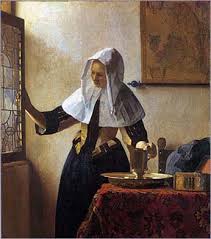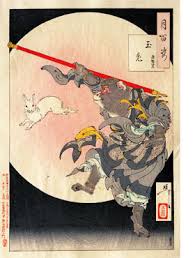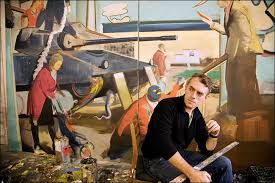 The life and art of Johannes Vermeer are closely related to the city of Delft. He was born in Delft in 1632 and lived there until his death in 1675. His father, Reynier Vermeer, was a weaver of silk occurred "Kaffa", a satin fine, but in 1631 Reynier also registered in the Guild of St. Luke in Delft as master art dealer. Reynier in 1641 was prosperous enough to buy a big house, the "Mechelen", which contained an inn in the market square in Delft, where he probably also sold paintings. Reynier When Johannes died in 1652 apparently inherited his father's business. At that time must have already decided on a career as a painter. Assumed to be formed in Delft, perhaps Leonaert Bramer (1596-1674), who seems to have had a close association with the Vermeer family, or Carel Fabritius (1622-1654). No documents, however, exist about his artistic training or apprenticeship, and he may have studied elsewhere, perhaps in Utrecht or Amsterdam.
The life and art of Johannes Vermeer are closely related to the city of Delft. He was born in Delft in 1632 and lived there until his death in 1675. His father, Reynier Vermeer, was a weaver of silk occurred "Kaffa", a satin fine, but in 1631 Reynier also registered in the Guild of St. Luke in Delft as master art dealer. Reynier in 1641 was prosperous enough to buy a big house, the "Mechelen", which contained an inn in the market square in Delft, where he probably also sold paintings. Reynier When Johannes died in 1652 apparently inherited his father's business. At that time must have already decided on a career as a painter. Assumed to be formed in Delft, perhaps Leonaert Bramer (1596-1674), who seems to have had a close association with the Vermeer family, or Carel Fabritius (1622-1654). No documents, however, exist about his artistic training or apprenticeship, and he may have studied elsewhere, perhaps in Utrecht or Amsterdam.Vermeer, who was baptized on 31 October 1632 in the Reformed Church in Delft, was raised a Protestant. In April 1653, however, Vermeer married a Catholic and seems to have converted to Catholicism shortly before that date to placate her future mother in law, Maria Thins. Maria Thins lived in the "corner of the papists'" ( "Papenhoek") of Delft, adjacent to one of two hidden churches where Catholics could worship, the church of the Jesuits in the Langendijck Oude. Vermeer and his wife, Catharina bolna, moved from the "Mechelen" at home. They named their first daughter, Mary, in honor of Maria Thins, and their first son Ignatius, after the patron saint of the Order of the Jesuits.
Vermeer became a master in the Guild of St Luke on 29 December 1653. Pictures of his aspiration that the time seems to be a history painter, his early works were large-scale mythological and religious. Shortly after he began painting genre scenes, landscapes and allegories of which has become so famous. While Vermeer's subject matter changed in the mid-1650s, however, continued to imbue his later works with the quiet, intimate moods in his paintings that he preferred the early history.
Although little is known about relationships with other painters who might have influenced the thematic and stylistic direction of his art, it seems, knew Vermeer, Gerard ter Borch II, who co-signed a document in 1653. Another artist might have had an impact on their work during the 1650s was Pieter de Hooch, an artist who painted scenes in Delft during the comparable period. Vermeer is still a respected artist in Delft during the rest of his life. He was appointed hoofdman Association of St. Luke in Delft in 1662, 1663, 1670 and 1671.
Some works by Vermeer - the thirty-five years - were not well known outside of Delft, perhaps because many of them focused on the recovery of a pattern in Delft, which seems to have had a special relationship with the artist. When Vermeer died, however, was heavily in debt, partly because his art dealing business had suffered during times of economic hardship in the Netherlands in the early 1670s. After his death he was survived by his wife Catharina and eleven children, eight of whom were minors. His wife filed for bankruptcy the following year. Antonie van Leeuwenhoek, the microscope of Delft, famous, who was apparently a friend of Vermeer, was appointed administrator of the estate.
Tags: Art, Painting

 In the following pages provides a brief online tour of the Japanese art collection of LACMA. This tour includes sculptures, paintings, prints and ceramics. For more information on Japanese art, please visit our collection in person or call the Department of Japanese Art at (323) 857-6565. Also visit our Collections Online.
In the following pages provides a brief online tour of the Japanese art collection of LACMA. This tour includes sculptures, paintings, prints and ceramics. For more information on Japanese art, please visit our collection in person or call the Department of Japanese Art at (323) 857-6565. Also visit our Collections Online. Tio Tjay (born in 1946 with the name Hok Tjay Tio) is an Indonesian painter who settled in Brazil a long time. In 1967 he immigrated to the South American country with his family who moved there.
Tio Tjay (born in 1946 with the name Hok Tjay Tio) is an Indonesian painter who settled in Brazil a long time. In 1967 he immigrated to the South American country with his family who moved there.
 Council officials have painted over a Banksy graffiti sketch of a new version was derived as the cover artwork for Beat Crazy 2003 single by the band Blur.
Council officials have painted over a Banksy graffiti sketch of a new version was derived as the cover artwork for Beat Crazy 2003 single by the band Blur. Abstract painting still looking for by foreign artists, though the triumph of the work of these canvases in the development of modern art has been passed.
Abstract painting still looking for by foreign artists, though the triumph of the work of these canvases in the development of modern art has been passed. Near the end of the late Gothic period, the oldest art centers of Germany and the Netherlands, went into decline. Cities such as Antwerp and Nuremberg, very quickly took over the lead role in the development and diffusion of the Renaissance style - not only in painting but also in other art forms. The main support for these events came from a wide network of humanist circles. Albrecht Dürer, who brought the new style of Nuremberg after his visits to Venice (1494-95 and 1505-07), became the founder of Renaissance southern Germany. The composition of the figures in his paintings shows a precise observation of the anatomy, understanding of perspective and a new vibrant use of color. His study of antiquity and Italian Renaissance was the basis of their new images.
Near the end of the late Gothic period, the oldest art centers of Germany and the Netherlands, went into decline. Cities such as Antwerp and Nuremberg, very quickly took over the lead role in the development and diffusion of the Renaissance style - not only in painting but also in other art forms. The main support for these events came from a wide network of humanist circles. Albrecht Dürer, who brought the new style of Nuremberg after his visits to Venice (1494-95 and 1505-07), became the founder of Renaissance southern Germany. The composition of the figures in his paintings shows a precise observation of the anatomy, understanding of perspective and a new vibrant use of color. His study of antiquity and Italian Renaissance was the basis of their new images. Several of his paintings and relief had decorated office and residence of Aceh and East Borneo Governor, Kantor Kehutanan at Banda Aceh and Samarinda, Banking-Hall BRI Surakarta, Museum Istana Presiden RI, Jakarta, Dep. P & K RI Jakarta, Galeri TIM Jakarta, Podium Bank EXIM Exim Plaza Jakarta, Office of Sri sultan Hamengku Buwono IX, Kepatihan Yogyakarta.
Several of his paintings and relief had decorated office and residence of Aceh and East Borneo Governor, Kantor Kehutanan at Banda Aceh and Samarinda, Banking-Hall BRI Surakarta, Museum Istana Presiden RI, Jakarta, Dep. P & K RI Jakarta, Galeri TIM Jakarta, Podium Bank EXIM Exim Plaza Jakarta, Office of Sri sultan Hamengku Buwono IX, Kepatihan Yogyakarta. Decorating your home can sometimes feels like an overwhelming task, but it doesn't have to be. Break your home decorating down by room.
Decorating your home can sometimes feels like an overwhelming task, but it doesn't have to be. Break your home decorating down by room.